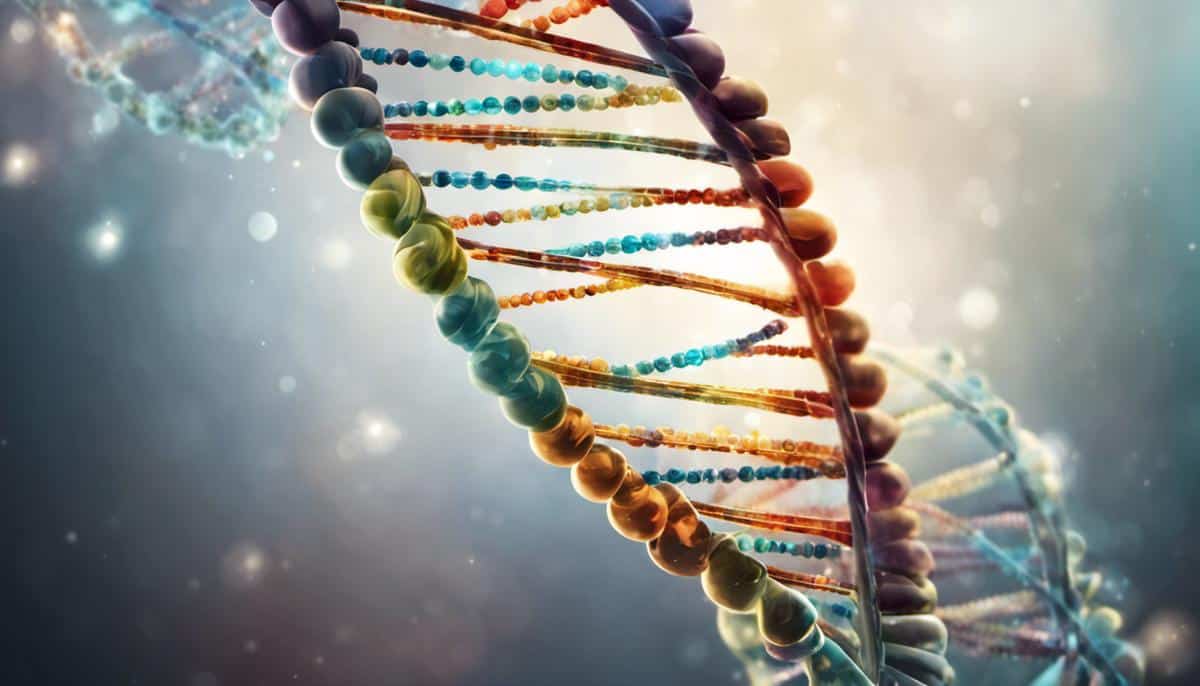In the fascinating tapestry of our personal history, understanding our paternal lineage forms a key thread.
The contributions of our fathers and their fathers before them forge a chain of biological inheritance that marks our unique genetic identity.
Through the lens of molecular genetics, we can peel back this complex layer and strive to understand how genes from our paternal lineage shape our individuality.
With the advent of modern DNA testing services, we can now trace the paternal lineage with incredible precision, revealing fascinating details about our ancestry and geographic origins.
This article provides a thorough insight into tracing paternal lineage through DNA testing, focusing on understanding genetic markers and evolving technologies.
It delves into the methodologies and interpretations associated with these advanced tests.
Discover your ancestral secrets! Explore our latest article, “Tracing Ancestors | Free Starter Guide”, and unlock the stories of your ancestors.
Begin your journey to unveil your family history with a single click. [Dive In Now!] 🌳🔍
Explore Your Paternal Lineage with Comprehensive Y-DNA Testing
Connecting with Distant Relatives Through Y-DNA Testing
- Y-DNA testing is a powerful tool used in genetic genealogy to trace one’s paternal lineage.
- Through Y-DNA testing, individuals can explore their ancient paternal roots, discover distant relatives, and understand the geographical migration patterns of their ancestors.
- This form of testing analyzes the Y chromosome, which is passed from father to son, making it a key element in uncovering the mysteries of one’s paternal lineage.
Who is Eligible for Y-DNA Testing?
Y-DNA testing is specifically designed for males, as the Y chromosome is unique to them.
Women who wish to trace their paternal lineage may consider asking a male relative from their father’s side to take the test.
By embarking on Y-DNA testing, you can expect to gain detailed insights into your paternal ancestry, unlocking doors to past generations and enhancing your understanding of your family’s historical journey.
FamilyTreeDNA
Why choose FamilyTreeDNA?
FamilyTreeDNA is a pioneer in the field of genetic genealogy and offers a robust variety of Y-DNA testing options. Here’s why you might consider FTDNA for tracing your paternal lineage:
- Depth of Testing: Offering a range of Y-DNA tests that examine different numbers of markers, FTDNA allows for a flexible and detailed exploration of your paternal ancestry.
- Database and Community: With an extensive database, FTDNA provides a rich resource for matching and connecting with relatives, alongside a supportive community of users and experts.
- User-Friendly Tools: FTDNA provides intuitive tools and resources that make it easier to dive deep into your ancestral journey and interpret your genetic data.
Living DNA
Why choose living DNA?
Living DNA provides a comprehensive ancestry test that includes Y-DNA analysis, making it a solid option for exploring paternal lineage. Here’s why living DNA stands out:
- Detailed Regional Breakdown: Living DNA offers a nuanced view of your ancestry, providing detailed regional and, in some cases, sub-regional breakdowns.
- All-in-One Test: While their ancestry test includes autosomal DNA analysis, it also includes Y-DNA (for males), providing a well-rounded view of your lineage.
- Global Comparison: The company offers a feature that allows you to compare your DNA with different world populations, aiding a broader understanding of your genetic ancestry.
Choosing a company for Y-DNA testing involves considering various factors, such as:
- The depth and breadth of the test,
- User interface,
- Customer service,
- The richness of the database for genetic matching and research.
These two companies, with their distinct offerings, stand as reliable options for individuals looking to explore their paternal lineage.
Understanding Genetic Markers in Paternal Lineage
Tracing Paternal Lineage: The Role of Y-Chromosomes and Mitochondrial DNA
The fascinating world of genetics paints multifarious narratives about human migration, lineage, and ancestry.
Two pivotal genetic markers, specifically Y-chromosomes and mitochondrial DNA, significantly contribute to the tracing of paternal lineage.
It’s an engrossing story of human history, often overlooked, but absolutely pivotal in the scientific community’s endeavor to understand human genomics.
- The Y-chromosome, primarily inherited from fathers to their sons, is a non-recombining area of the human genome.
- This means that the Y-chromosome sidesteps the deck-shuffling process of genetic recombination that typically occurs during the production of sperm or eggs.
- As a result, the Y chromosome is passed along almost identically from father to son, with only minute changes or mutations in its sequence occurring across generations.
- These telltale mutations act as breadcrumbs in the genomic context, leading us back through time to trace paternal lineage.
One widely used method in paternal ancestry tracing is the Y chromosome haplogroup determination.
Within a haplogroup, all members share a common ancestor, thus constructing a phylogenetic tree that routes back thousands of years.
This analysis is extensively used in genetic genealogy, and it has potential applications in disease tracing and forensic science.
- Turning to mitochondrial DNA (mtDNA), however, nuances exist.
- Although mtDNA is typically associated with matriarchal lineage tracing due to its exclusive inheritance from the mother.
- Its role in paternal lineage tracing should not be dismissed.
- Novel research demonstrates occasional instances of paternal transmission of mtDNA.
- Challenging the long-standing notion of strictly maternal inheritance.
- Although unusual and sporadic, these exceptions are transformative for lineage tracing and bear witness to the dynamism of genetic science.
An emerging area of research revolves around the potential influences of paternal mitochondria on offspring health.
The paternal mitochondria typically decompose after fertilization, but when this doesn’t occur, it can impact the offspring’s health.
This anomaly opens new research avenues for understanding inherited diseases.
Thus, the transmission of paternal mtDNA holds significant implications not only for genealogy but also for medical genetics.
There’s a clear indication of the substantive role played by Y-chromosomes in tracing paternal lineage due to their nearly unblemished transmission from father to son.
On the other hand, mitochondrial DNA, though usually maternally inherited, occasionally plays a less dominant yet undeniable role in paternal lineage tracing.
Modern science persistently unravels the complexities of human genetics, enhancing the richness of this field.
This continuous discovery contributes to our ancestry knowledge and fosters advancements in medicine.

The Evolution of DNA Testing for Paternal Lineage
The Evolution of Lineage Tracing: Advances in DNA Testing Techniques and Technology
DNA testing has evolved into a sophisticated field, fueled by the necessity to trace lineage accurately and unveil our ancestors’ origins and journeys.
It constantly adapts, seeking to answer fundamental questions about our ancestral history.
Technological advancements in the field have paved the way for new, exciting avenues to explore these queries.
- In lineage tracing, the use of autosomes – the non-sex chromosomes – has emerged as a valuable tool.
- Unlike Y-chromosomes and mitochondrial DNA, which are passed on relatively unchanged, autosomes recombine each generation.
- This results in a mixing of the genetic contributions from both parents, offering a more complex and intricate tracing of ancestral lines.
- It was historically deemed challenging to identify the origins of particular autosomal markers.
- However, advances in computational genetics have greatly accelerated our ability to diagnose these with accuracy and precision.
One such advance is the advent of Single Nucleotide Polymorphism (SNP) testing.
SNPs are single-base changes in the DNA sequence, serving as markers to identify a specific location on a specific chromosome.
They can reveal ‘blocks’ of DNA that are inherited together, creating a detailed roadmap of our genetic history.
With millions of SNPs identified in the human genome, they have become the cornerstone of genetic genealogy and opened up new frontiers in the study of both recent and ancient ancestry.
Further enhancement arrived with the advent of Whole Genome Sequencing (WGS).
WGS reads almost the entire DNA sequence, uncovering extensive information about our genetic makeup.
This has opened up a new dimension in lineage tracing, providing high-resolution maps of genealogic ancestry and shedding light on the deep history of humankind.
It also offers vast potential for future research, particularly in areas such as trait mapping and disease prediction.
DNA testing has also been revolutionized by the rise of direct-to-consumer (DTC) genetic testing.
These commercially available tests provide individuals with unprecedented access to information about their personal genetic ancestry.
DTC tests utilize arrays capable of analyzing hundreds of thousands of SNPs, promising a detailed investigation into an individual’s ancestral lineage.
Nonetheless, it should be stressed that these services are best viewed as tools of exploration rather than fixed maps of ancestry.
Genetic heritage is a complex and intricate field that continues to offer new insights.
As we delve deeper into the complexities of the human genome, a steadfast commitment persists within the academic and scientific communities.
There is a continuous effort to develop and embrace newer technologies. These advancements are pivotal in enriching our understanding of lineage tracing.

Methodology and Interpretation of Paternal Lineage DNA Tests
Advancements in Computational Genetics
- Upon already exploring the roles of Y-chromosomes, mitochondrial DNA, and the possible impact of paternal mitochondria on offspring health,
- It’s now salient to expound upon the crucial aspect of autosomes and their significance in lineage tracing.
- Autosomes, which constitute 22 of the 23 pairs of chromosomes in humans, carry a wealth of inherited information from both parents.
- These sizable beaters of genetic data allow for a more extensive exploration of a person’s lineage than solely focusing on the Y-chromosome or mitochondrial DNA.
The sheer abundance of autosomal DNA provides a far more intricate map of ancestral paths, telling more diverse stories of one’s heritage.
However, due to recombination, or the mixing of genetic material during sexual reproduction, autosomal markers often become a complex computational task, which brings us to the vital role of computational genetics.
Computational genetics advancements are transforming the diagnosis and understanding of autosomal markers.
Sophisticated algorithms now aid in sifting through and making sense of the vast amounts of data embedded in these autosomal markers.
These computational tools not only help visualize massive data sets but also assist in identifying patterns and links that further aid in accurately tracing lineages.
An utterly crucial innovation facilitating this tracing of ancestry is Single Nucleotide Polymorphism (SNP) testing, a method that identifies variations at single points in the DNA.
Tracking these SNPs provides insight into the common ancestors shared by groups of individuals.
Not only are SNPs indispensable in genetic genealogy research, but they also offer considerable value in biomedical research, unlocking the secrets of complex diseases.
A more recent technique, Whole Genome Sequencing (WGS), can provide high-resolution maps of genealogic ancestry.
By decoding the entire genome of an individual, WGS offers a complete and comprehensive picture of a person’s genetic makeup, leading to an unparalleled understanding of one’s lineage.
This technology, despite being relatively expensive, represents a significant leap forward concerning the resolution of data achievable.
This leads us to the rise of direct-to-consumer (DTC) genetic testing.
In an era where curiosity about one’s genetic makeup and lineage is more prevalent than ever, DTC genetic testing companies have experienced a bonafide boom.
They offer a seamless, user-friendly way for individuals to explore their genetic ancestry privately.
The ability to conduct a DNA test in the comfort of one’s home has completely democratized genetic genealogy.
While this surge in personal genetic exploration is generally positive, it’s also necessary to be aware of the complexities and limitations inherent in lineage tracing.
Genetic heritage interpretation remains a challenging task involving a gamut of considerations, including genetic drift, gene flow, and population histories.
Assumptions can lead to erroneous interpretations, underscoring the need for careful consideration when examining genetic testing results.
The academic and scientific community steadfastly devotes itself to overcoming these challenges, improving DNA testing techniques, and refining methodologies for accurate lineage tracing.
In such focused endeavors, the promise of robust, accurate genetic genealogy inches ever closer, rife with exciting insights and knowledge about our past and, indeed, our future.

The journey of exploring one’s paternal lineage using DNA testing is truly a remarkable blend of scientific innovation and personal discovery.
With the evolving advancements in DNA testing technology, our understanding of genetic markers and their significance in determining our paternal lineage continues to expand.
This deep dive into molecular genetics unravels the nuanced details of our personal history and opens up new vistas for comprehending our relationship with our ancestors.
As you embark on your journey to unravel your own genetic tapestry, this understanding will serve as your guiding compass.
It equips you with the knowledge to interpret your genetic markers, investigate your ancestry, and appreciate your unique genetic heritage.
Frequently Asked Questions (FAQ)
- What is the primary objective of tracing paternal lineage through DNA testing? Tracing paternal lineage through DNA testing aims to uncover one’s ancestry and gain insights into genetic origins and familial connections.
- How reliable are the results from DNA testing for paternal lineage tracing? The reliability of DNA testing for paternal lineage depends on various factors, including the methodology used and the quality of the sample. Most tests are highly reliable when conducted through reputable services.
- What types of DNA markers are significant in tracing paternal lineage? Y-chromosomes and autosomal DNA markers are essential in tracing paternal lineage, allowing for the identification of direct paternal ancestors and more extensive familial connections.
- How has the evolution of DNA testing technology improved the accuracy of lineage tracing? The advancement in DNA testing technologies, such as Whole Genome Sequencing and SNP testing, has significantly improved the accuracy and detail of lineage tracing.
- Is it possible to discover specific geographic regions of ancestry through paternal lineage DNA testing? Yes, DNA testing for paternal lineage can often provide insights into the geographic regions where one’s ancestors originated, helping to map out historical family migrations.








